Blog
December 25th, 2009

Every year I whip up a little holiday postcard and send it winging to far-flung friends and family. It’s a long-standing tradition of mine, and an important constant when many other holiday plans change from year to year. This year’s card reflects my own personal plans for Christmas this year—I fully intend to spend some serious quality time with needles and wool.
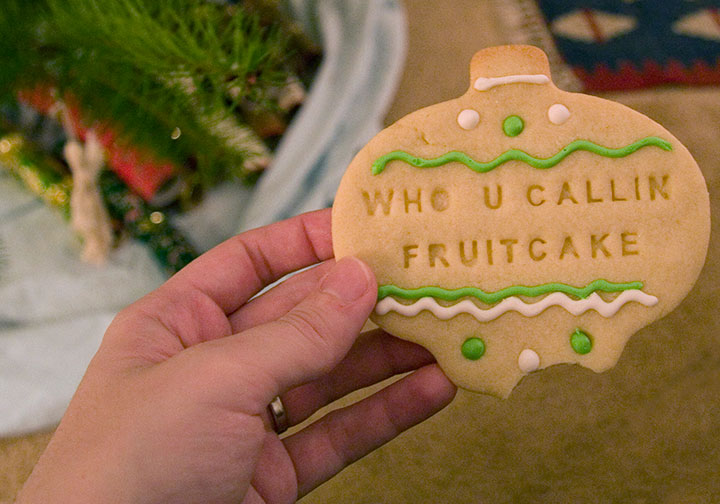
We’re staying home and having our own Christmas this year, and along with rare treats like time for knitting and the luxury of jigsaw puzzles, the celebrations come complete with seasonal goodies (like these saucy sugar cookies made by my friend Maggie)…
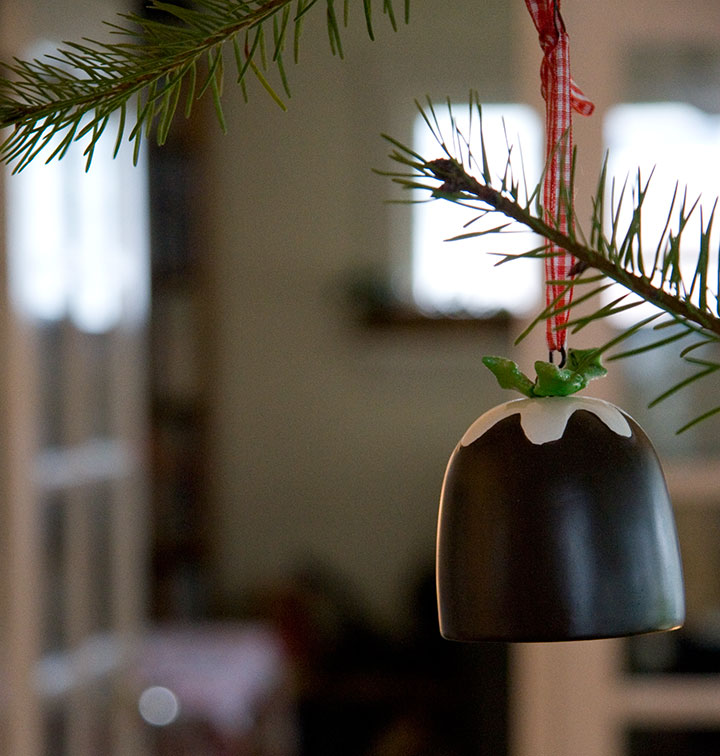
…cozy surroundings…
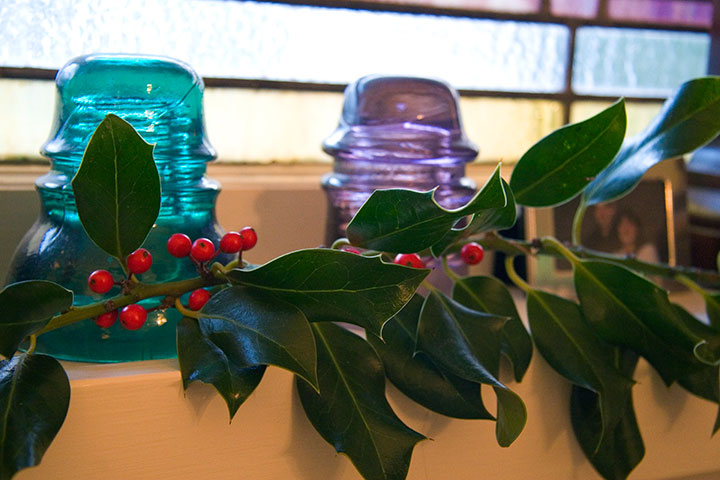
…and all the comforts of home. So this is my Christmas card to you. Wishing you the merriest of holidays, and a new year filled with peace, love, and joy.
December 22nd, 2009
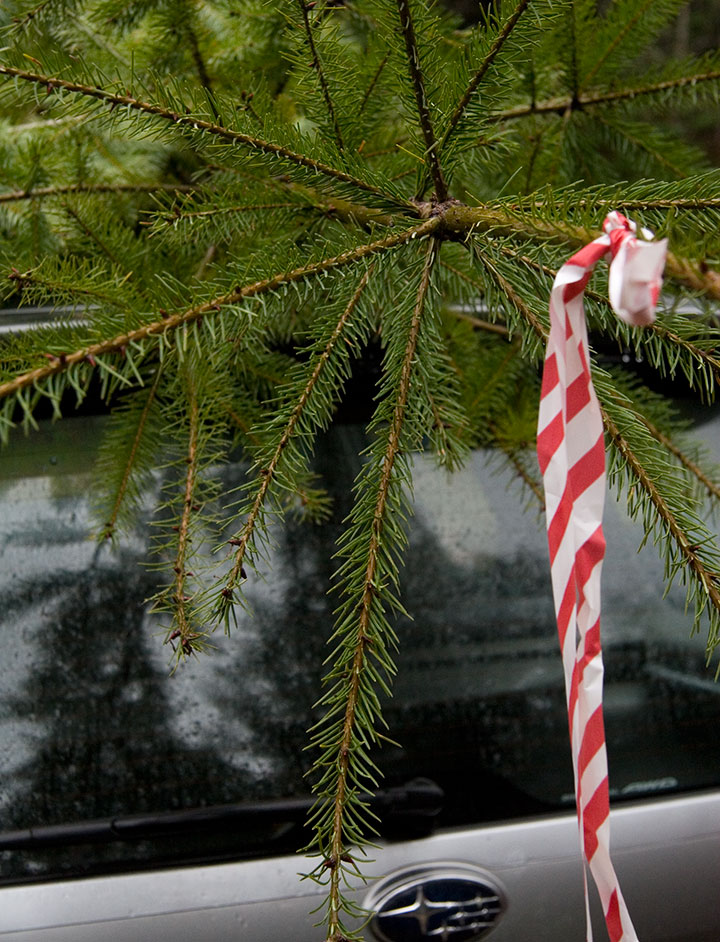
If you’ve been reading this blog for awhile, or you’ve met me or the Tailor, you already know about our penchant for storing food and taking seasonal eating to hardcore extremes. But our nuttiness about walking the talk extends far beyond the pantry. Another aspect of our attempts to live as sustainably as we can is our rejection of synthetic materials. Now, we’ll never live entirely free from petroleum products—we drive a car. We own a refrigerator, a stereo and a plethora of records, tapes, CDs and DVDs. I use a computer, a scanner, a digital camera, and a host of accompanying accessories. I’m not about to buy underwear with a button waist. I gleefully print with photopolymer plates. And we just can’t let go of our small, sentimental collection of deliciously hideous, ancient Tupperware. But all things considered, you’d be hard-pressed to find much plastic in our house. Whenever possible we buy clothing, tools, containers, furniture, and everything else made purely from natural materials: wood, metal, glass, cotton, linen, wool, silk, bamboo, cork, bone, shell. Much of the time, nowadays, that means we have to look for vintage versions of whatever we’re shopping for, but you’d be surprised at what’s available—as long as one is willing to search for it. I know how extreme this position is—and believe me, it’s not something that can be done overnight. This is a process years in the making, and just the fact that we’re still working at it (and probably always will) shows that it’s not for everyone, and certainly not the only solution out there. But the biggest benefit of it all is how long-lasting our belongings are—and when things break, they can usually be mended, rather than thrown away and replaced.
The biggest downside, however, is that by choosing this path we also choose to abstain from some creature comforts and cultural elements that are dated from after the advent of plastic. Most of the time I don’t miss it—or even notice anything lacking. But right now, during the holiday season, I have a fierce craving for twinkle lights that I just have to resist (if anyone can find me twinkle lights made entirely of glass bulbs, metal wire and cloth cord, I’ll be all over it).
Even with our solemn vows to thwart plastic, our search for a Christmas tree left us in some doubt (I grew up with an artificial tree, and have only had one Christmas tree of my own—a real one, three years ago). Is it better to buy a fake tree once or intentionally kill fifty-odd living evergreens in one’s lifetime? Which is worse—fossil fuels or deforestation? How about burning fossil fuels on our way to deforest a section of land?! (The irony of the freshly-killed tree tied to a hippie Subaru in the above photo isn’t lost on me.) And can one family really do so much damage just by celebrating the holidays, or should we just stop worrying so much?
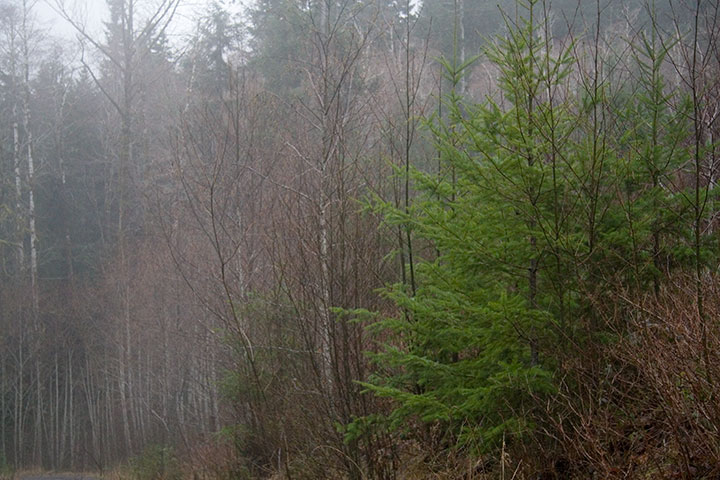
In the end, we followed the same instincts we rely on for our choice to remain omnivores: we decided on a real tree (after all, we do live in a place with abundant trees that shoot up fast, thanks to our rainy climate), as long as it could be culled responsibly. So we called up some friends who own land near Olympia, and as luck would have it, there were some young Douglas-firs on their property that were scheduled to be removed in the spring.
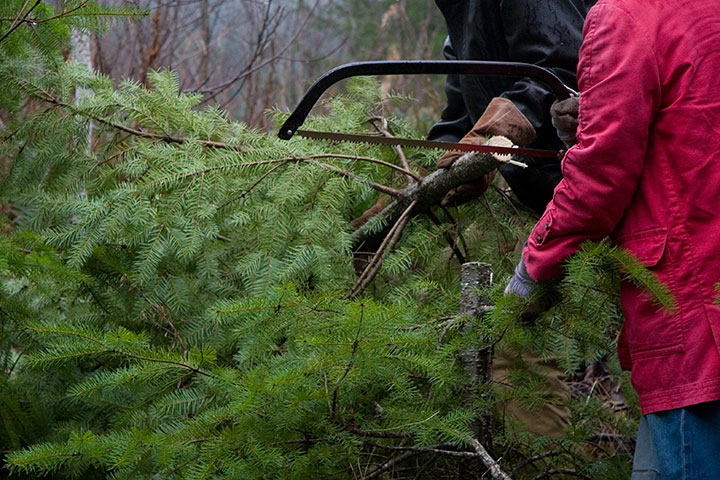
A little elbow grease later, we had our Christmas tree.
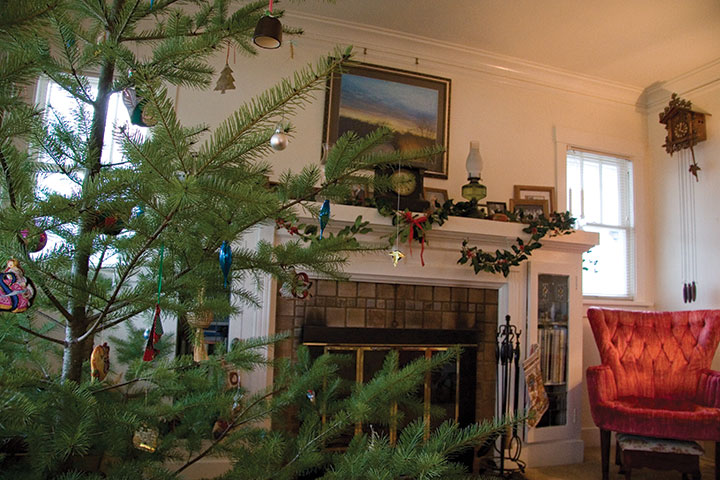
It doesn’t have the textbook perfection of a farmed tree, but it looks lovely in the living room, bedecked in handmade and vintage ornaments (I think there are exactly four plastic items contained therein). And as we decorated it on the solstice, I privately gave thanks to the land for contributing to our holiday.
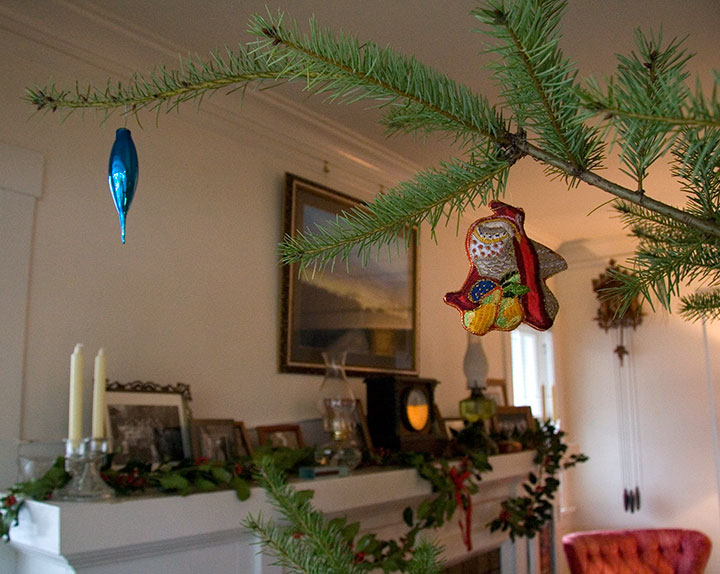
Now that we live in a house with a fireplace, we can finally hang the stockings by the chimney with care. And with a fireplace comes a mantel just begging to be decorated.
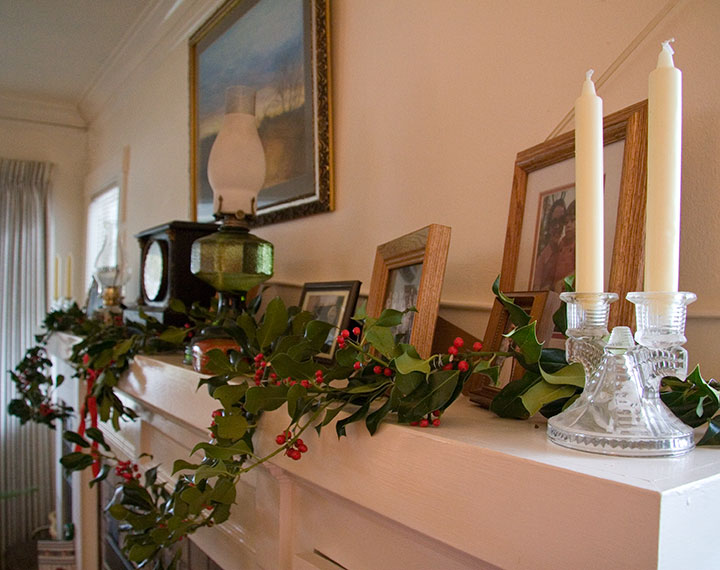
So another friend invited us to clip some holly branches (holly is a beautiful but noxious weed around here, so pruning is always welcome) from his back yard, and with the help of a little steel wire I whipped up a Christmas garland.

We used a bit of leftover holly and some cedar prunings for a wreath, and suddenly it was Christmas at our house. So maybe I don’t have my beloved twinkle lights, but somehow it feels better this way. We had a big holiday potluck last night, with thirty or so people crammed into our living and dining rooms, bellowing carol harmonies and exploding crackers and cheering when the Tailor poured blue-flaming brandy on the plum pudding. And nearly every one of them said it felt like their grandmother’s house, or their childhood traditions, or what they imagined of Christmases past. So maybe I don’t so much need that string of lights.
Still, since the moment we decided on a real tree I’ve been reminded of my favorite Robert Frost poem—which might make me all the more conscious of our choice, but also more appreciative of the holiday in general. After all, a Christmas tree is something the city “could not do without and keep its Christmas.”
Christmas Trees
(A Christmas Circular Letter)
The city had withdrawn into itself
And left at last the country to the country;
When between whirls of snow not come to lie
And whirls of foliage not yet laid, there drove
A stranger to our yard, who looked the city,
Yet did in country fashion in that there
He sat and waited till he drew us out
A-buttoning coats to ask him who he was.
He proved to be the city come again
To look for something it had left behind
And could not do without and keep its Christmas.
He asked if I would sell my Christmas trees;
My woods—the young fir balsams like a place
Where houses all are churches and have spires.
I hadn’t thought of them as Christmas Trees.
I doubt if I was tempted for a moment
To sell them off their feet to go in cars
And leave the slope behind the house all bare,
Where the sun shines now no warmer than the moon.
I’d hate to have them know it if I was.
Yet more I’d hate to hold my trees except
As others hold theirs or refuse for them,
Beyond the time of profitable growth,
The trial by market everything must come to.
I dallied so much with the thought of selling.
Then whether from mistaken courtesy
And fear of seeming short of speech, or whether
From hope of hearing good of what was mine,
I said, “There aren’t enough to be worth while.”
“I could soon tell how many they would cut,
You let me look them over.”
“You could look.
But don’t expect I’m going to let you have them.”
Pasture they spring in, some in clumps too close
That lop each other of boughs, but not a few
Quite solitary and having equal boughs
All round and round. The latter he nodded “Yes” to,
Or paused to say beneath some lovelier one,
With a buyer’s moderation, “That would do.”
I thought so too, but wasn’t there to say so.
We climbed the pasture on the south, crossed over,
And came down on the north.
He said, “A thousand.”
“A thousand Christmas trees!—at what apiece?”
He felt some need of softening that to me:
“A thousand trees would come to thirty dollars.”
Then I was certain I had never meant
To let him have them. Never show surprise!
But thirty dollars seemed so small beside
The extent of pasture I should strip, three cents
(For that was all they figured out apiece),
Three cents so small beside the dollar friends
I should be writing to within the hour
Would pay in cities for good trees like those,
Regular vestry-trees whole Sunday Schools
Could hang enough on to pick off enough.
A thousand Christmas trees I didn’t know I had!
Worth three cents more to give away than sell,
As may be shown by a simple calculation.
Too bad I couldn’t lay one in a letter.
I can’t help wishing I could send you one,
In wishing you herewith a Merry Christmas.

December 6th, 2009
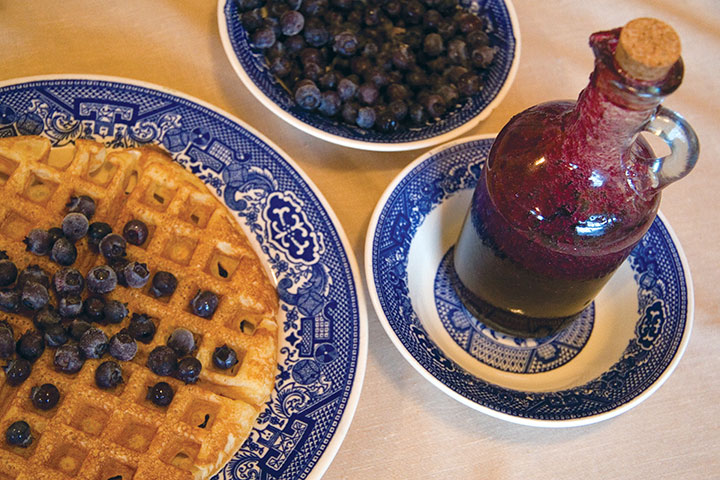
For months now we’ve been finding new ways to use our stores of dried, home-canned and preserved blueberries. But we almost forgot about the containers of fresh berries we threw in the freezer—and on this unseasonably cold* morning, whipping up a little reminder of summer seemed like a good idea.
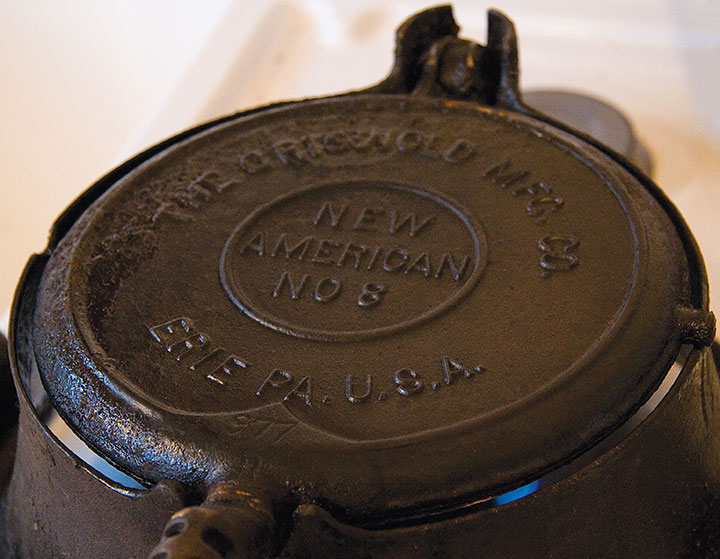
So the Tailor fired up the Cast-Iron Stovetop High-Collared No. 8 Griswold Waffle Iron™ (say that five times fast!), and we had ourselves a good old-fashioned hot breakfast—which, incidentally, goes great with the homemade blueberry syrup above, but the Tailor won’t share that recipe, I’m afraid.
No-Kiddin’ Waffles
2 ¼ cup flour
4 tsp. baking powder
¾ tsp. salt
1 ½ Tbsp. sugar
2 eggs, beaten
2 ¼ cup whole milk
½ cup oil (we use Canola)
Sift the flour, baking powder and salt three times, then add the sugar. In a separate bowl, mix the beaten eggs, milk and oil. Add this to the dry ingredients and mix thoroughly. While some people like to make their batter ahead of time, we’re firm believers in using fresh-fresh-fresh batter. So for best results, make your waffles right then and there.
Oil your cast-iron waffle iron well before starting. Heat both sides of the iron thoroughly (the advantage of a high-collared iron like this is even heating and plenty of room to flip waffles), and remember to apply oil after every third or fourth waffle—a bristle brush is handy for this.

Use a 1/2 cup measure to dip batter—one dip per waffle—and pour the batter into the center of the iron. When you close the lid, the batter will wick evenly into all the nooks and crannies.
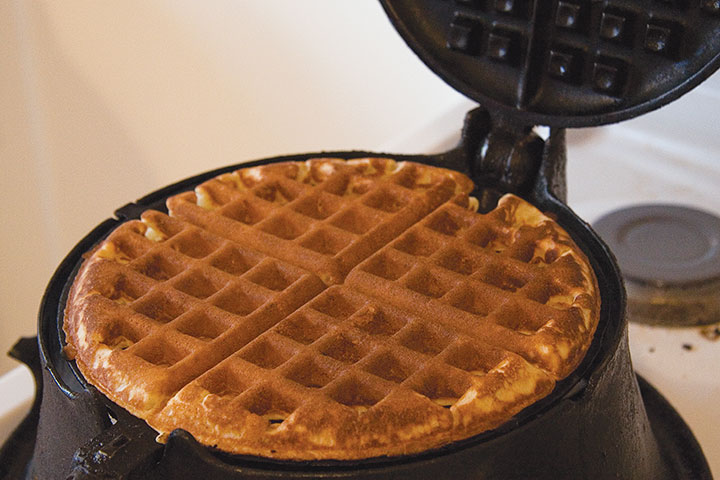
Cook the waffle for 3-4 minutes (peek occasionally to make sure your iron isn’t too hot!), flipping frequently—every thirty seconds or so. The best part (other than the flipping, that is)? Waffles are kind of like pizza—you can jazz them up however you like with your favorite breakfast condiments. But eat ’em fast—a jazzed-up waffle will get cold and soggy** before too long.
That’s never a worry around here, though—these babies get gobbled up long before the next waffle is ready!
• •••••••• ••••••••• ••••••••• ••••••••• ••••••••• ••••••••• •••••••••
* I know all you Minnesotans are rolling your eyes at this declaration, but a nighttime temperature of 17°F is enough to force us to rescue our squash colony from the attic, which isn’t insulated for “real” winter. So until the attic temperature stays above freezing, our pumpkins and butternuts are living in the spare bedroom like edible houseguests—definitely one of the less glamorous aspects of living seasonally.
** I’m really into the specific heat of foods. Mashed potatoes? High specific heat. Fresh waffles? Sadly low.
October 14th, 2009
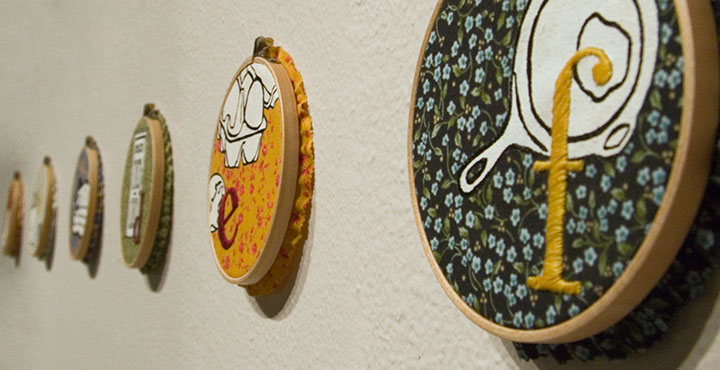
When I walked into the PLU Gallery this morning to document the Mnemonic Sampler show when it opens, my brain had somewhat of a short circuit. Since I was out of town for the past few days, all of the installation work was done for me (thank you a million times over, Heather C.!)—so this was the first time I’d laid eyes on the work since framing it up and chucking the pieces in a box. I somehow couldn’t connect the finished work on the walls with the crazy, chaotic process of the past few months. It seemed so simple, like this was somebody else’s show, and all the nail-biting and never-ending futzing I’d been doing was for some other project that would remain unfinished forever. But I did finish it—and there it is!
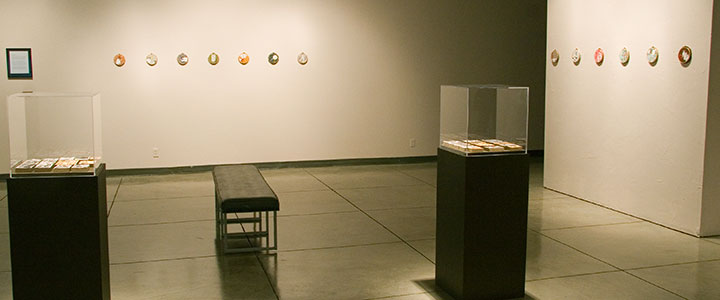
I was nervous about the possible absurdity of having twenty-six small pieces in a colossally huge space, but somehow, it works. Heather ingeniously used lighting and visual breaks to transform the gallery into a space that draws the viewer in and creates an intimate experience—which is exactly what I hoped for. Heather, I owe you big.
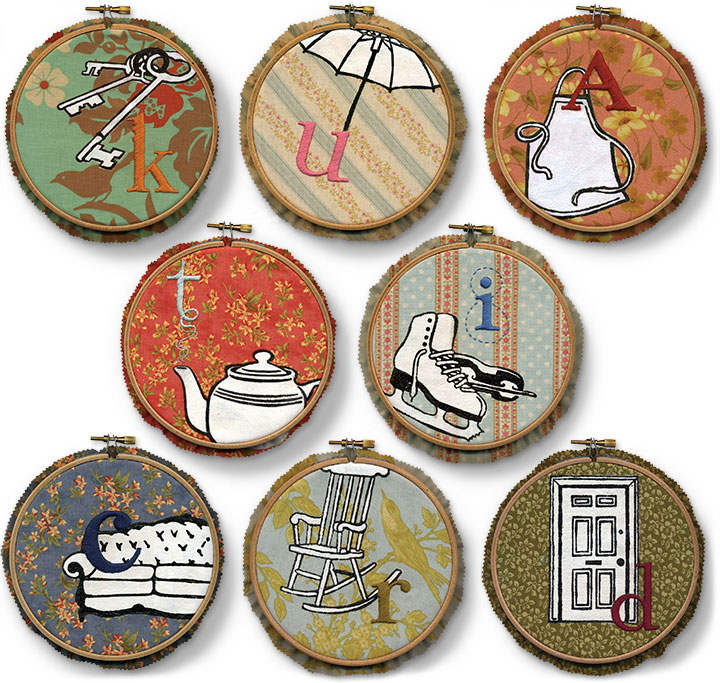
On to the work itself. Here is the artist statement for the exhibit:
The alphabet is one of the first lessons we learn as children. From the beginning we learn to use it as a mnemonic device—just like “Roy G. Biv,” or “Every Good Boy Deserves Fudge”—assigning meaning to our world by associating symbols with each letter. Because the alphabet is one of our most basic and effective memory tools, we are drawn to it as both a visual and narrative archetype. It’s not surprising, then, that the abecedary is somewhat of a staple among book artists.
Just as we use our ABCs as a memory aid, our possessions help us create the concept of Home. No matter what our economic station, living situation, or domestic permanence, we all tend to share similar symbols of comfort and nostalgia. These ideals are embodied in the everyday objects around us—those mundane materials we take for granted, yet without which we would sense something lacking. As someone who has never had a picket fence, who grew up in a nomadic military family, and who has lived her entire life with relatively few possessions, the archetypal Home should seem foreign to me. Yet the same mnemonic triggers exist in my mind; the same objects attract me.
Mnemonic Sampler collects and files our household icons, gathered together like the stitched and quilted samplers of our mothers and grandmothers. The hand-stitched alphabet enumerates my, your, our trappings, shuffling our collective domestic inventory like the old card game of Memory. Each symbol is familiar; each object is Ours, whether we actually possess it or not. Together they sketch out a Home—real or imagined; longed-for or spurned; past, present, or future.
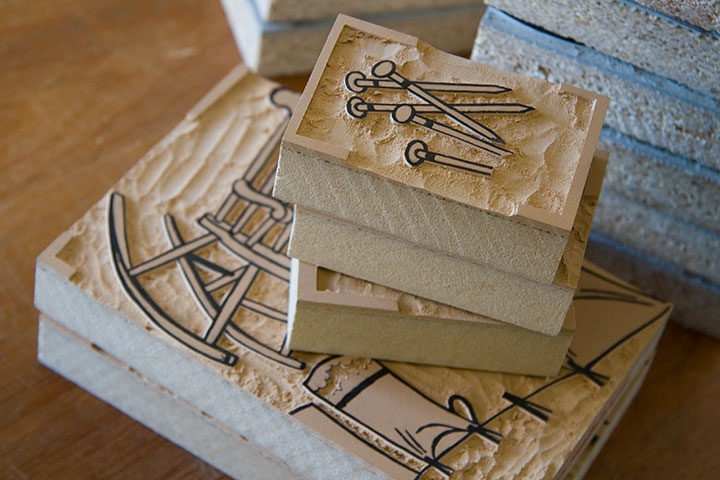
Mnemonic Sampler is a collection of monoprints, which means that instead of an edition of multiples, each print is created in such a way that it can’t exactly be reproduced. This technique results in a one-of-a-kind, totally unique piece—and is often more closely related to painting than printmaking. These pieces are printed from reduction-cut linoleum blocks—meaning both print colors are carved from the same block.
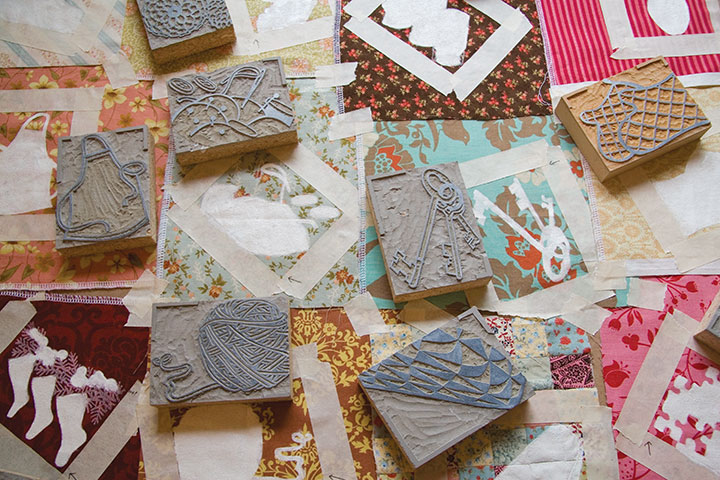
So once the second design is carved, the first color cannot be printed again.
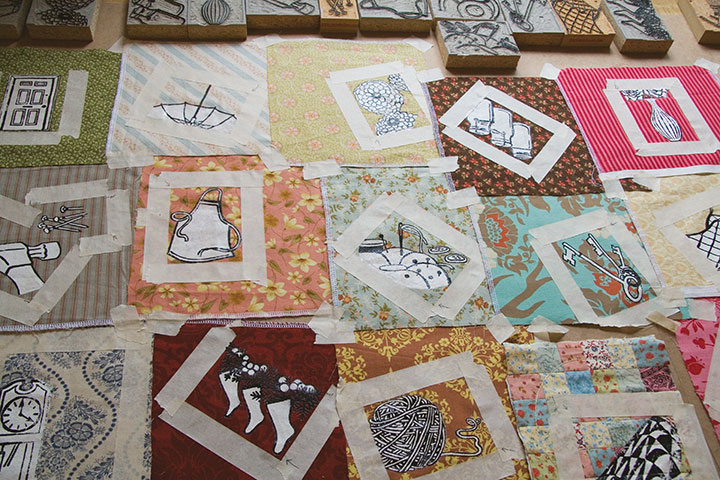
Designing these pieces was an intuitive process, consisting of both logical and intangible choices of fabric and pattern compositions. Because the design stage was so fluid (almost semi-conscious at times), it really wasn’t possible to do the printing on a press. Instead, each impression was made literally by hand, using masking tape to aid in color registration.

“Q” has an extra conceptual level, since the fabric background is a patchwork “quilt” in its own right. Like everything else about the series, the patchwork is sewn by hand, using the English paper piecing technique.
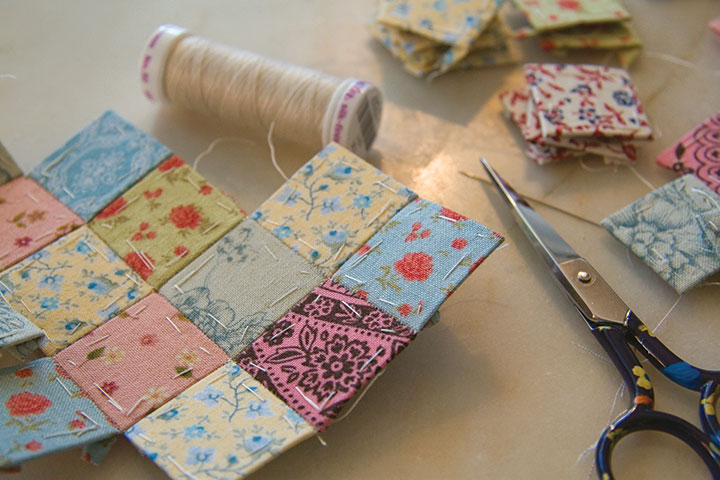
This was my first attempt at paper piecing, and I’m pleasantly surprised at how quick and accurate it is. Instead of folding and ironing every tiny piece, then wrangling a sewing machine, each patch is wrapped around a paper template and basted down, then whip-stitched together into a block.
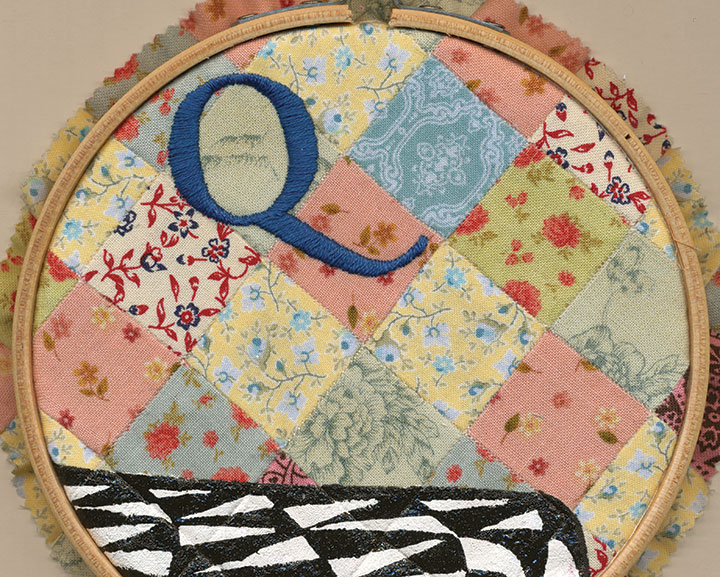
The result is a precise little quilt—perfect for embroidery.
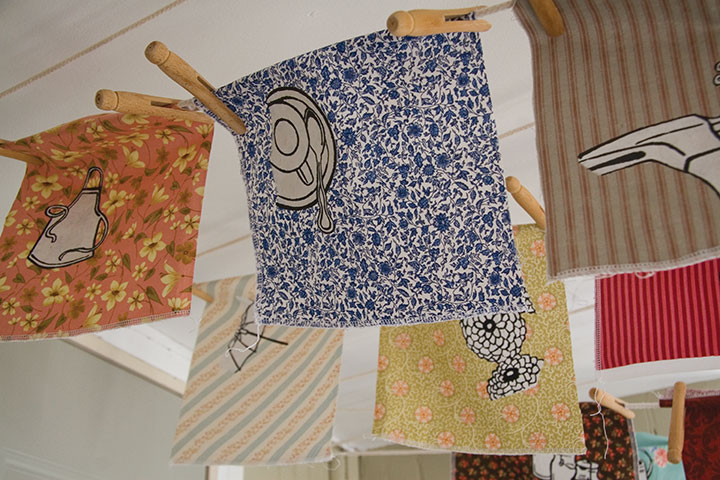
I can’t believe how long it took to complete every step of the process—and yet how quickly everything came together at the end. So you can bet I’m excited about celebrating at the opening tonight. And besides, I’m interested to see if the household objects I chose will resonate with viewers; it wasn’t easy to narrow things down to twenty-six letters of the alphabet, so I picked those objects that had the most meaning for me.
So how about it—what spells “Home” for you?
September 22nd, 2009
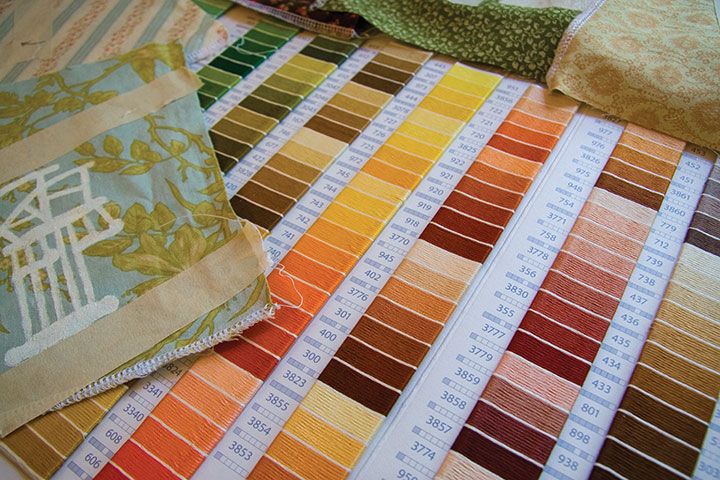
Swatch books are very near the top of my list of Favorite Things Ever. There is something so satisfying about having every color, pattern, texture, or finish right at your fingertips. I love sitting at my table, with a cup of tea in hand and six hundred sample chips spread out before me, ready for some serious color theory. (In case you’re wondering, this is the amaze-a-crazy DMC embroidery floss über color card. Well-made swatch books like this tend to be expensive to produce, and impossible to find once they go out of print. So if you’re into this sort of thing, I’d suggest snagging your copy before they decide to quit selling them.)
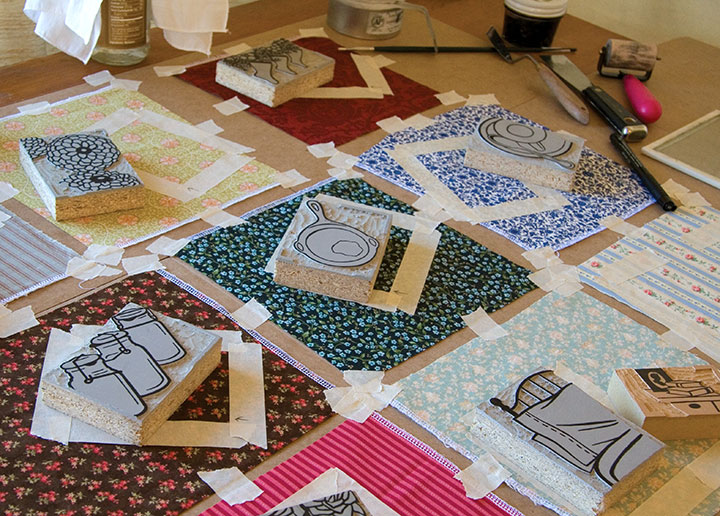
These days the studio has been an explosion of choices. Snippets of fabric and open dictionaries have taken over my life as I get ready for a new solo show, which opens October 14 at the Pacific Lutheran University Gallery. Stay tuned for more details in the next few weeks.
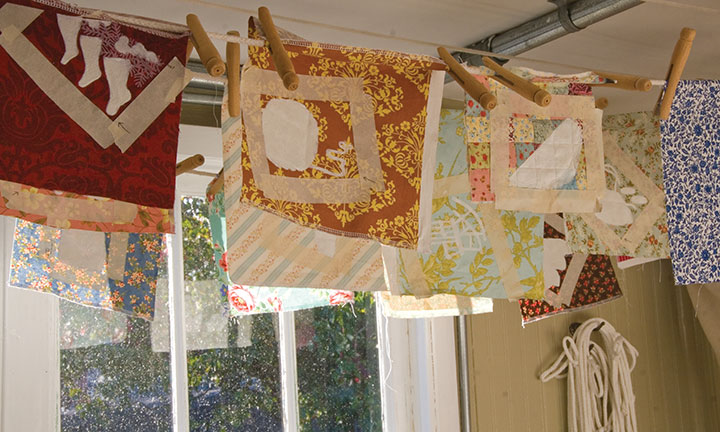
I wish I had something more concrete to show you, but this is one of those projects where everything comes together at once, right at the end (which can be as nerve-wracking as it is rewarding). I’ve got to say, though, that calico—finished or not—sure makes for pretty pictures.
September 13th, 2009
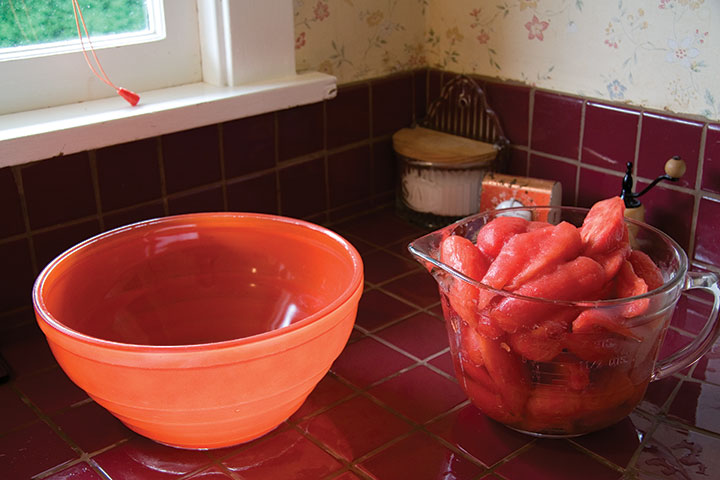
The season is turning ’round these parts—it seems the whole world is tinged with hints of red and gold. We had another warm weekend, but I’m not fooled; behind the hot sun are chill mornings and the rush of the harvest.
So it was another canning weekend for the Tailor, supplied by our latest farmer’s market haul and our final trip to the Blueberry Park for the year. We had to work hard for it yesterday, but amongst the nearly-spent, now-crimson bushes, we found just enough berries for one more batch of jam. Our total haul for the year? Over fourteen gallons of blueberries! In the spring we’ll return the favor by volunteering.
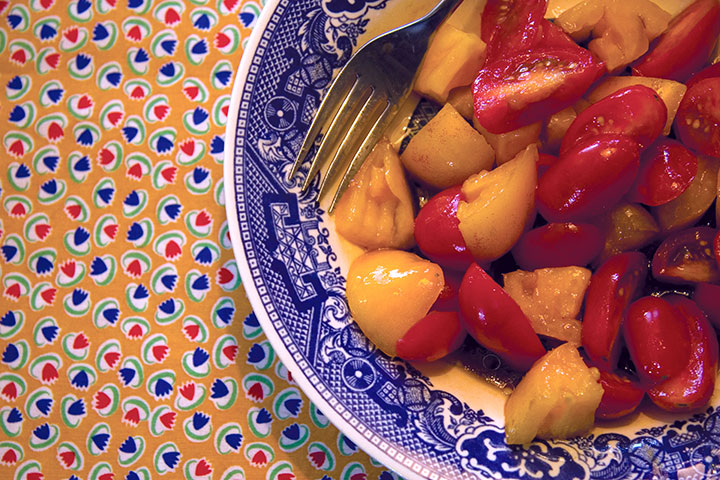
There’s no time to pine for berry season, though—now we’re up to our eyeballs in heirloom tomatoes (like these beauties from our favorite farm in the Puyallup Valley, splashed with a little oil and balsamic). And soon it’ll be time to get the root cellar and attic ready for a winter’s worth of squash, onions, potatoes, and pumpkins (more on that later). Marking transitions is my favorite part of eating seasonally, and autumn is my favorite time of year. I’ll be ready for fall’s bounty—camera in one hand, fork in the other.
July 29th, 2009
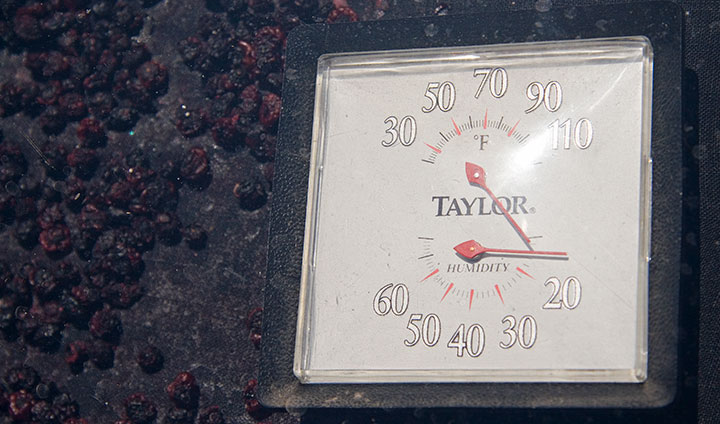
They’re predicting 105 degrees today here in T-town—that’s an all-time, record-breaking high. Now, if you’re in the Midwest, the South, or the Southwest and you’re reading this, you’re probably thinking, “And this is news how?” Well, this is where the part about “all-time” comes in—since white settlement of this area, at least, it has never, ever been this hot before. This place ain’t made for 105°. Almost nobody has air conditioning, but the discomfort is only the half of it. Who knows what this will mean for the snow pack in the mountains, or the water supply?
Beastly or not, though, it seemed a shame to let all this amazing solar energy go to waste. So over the weekend the Tailor devised a passive food dehydrator out of old window panes (buying an electric dryer, to us, seemed to defeat the purpose of home sustainability). Our first attempt at drying berries seemed successful, so at 5:30 this morning,before the heat kicked in, we headed to the Blueberry Park to pick about three gallons more. (The berries are happy with the heat, even if nobody else is!)

Here’s how it works: four nylon window screens (don’t use aluminum! It reacts with the food) hover over the pavement, propped up on wooden beams to allow for air circulation. Tied to each screen is a black linen cloth to absorb more heat and provide a clean surface for the food, while still letting air pass through. The glass windows fit right on top, providing the perfect space to trap hot air, just like a greenhouse.
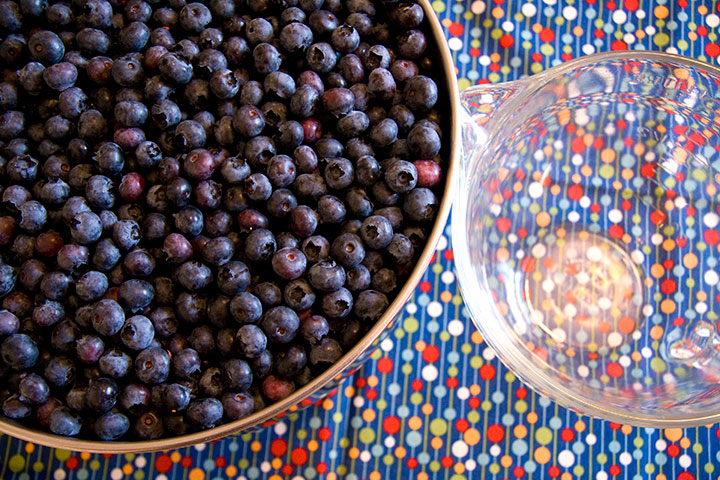
Now, on to the fruit itself. For blueberries, at least, the dried yield ends up being about a quarter of what you started with (so for example, two quarts of fresh berries will become about a pint dried), so it’s best to start with a big batch—another vote for a large, homemade drier over those tiny electric ones. Our drying system will hold five or six quarts of fresh berries.
Wash the berries and remove any stems, petals, grass and unripened fruit (and especially spiders!), and set a large stockpot of water to boil. Place about a quart of berries into a steamer —the berries will dry faster if you split the skins first, and smaller batches seem to be more effective than boiling the whole batch at once.

Once your water is boiling, put the steamer into the pot, and boil for thirty seconds—just long enough for the skins to split. Then remove the steamer and dump the hot berries into a colander in a cold sink (the ice water stops the cooking process).
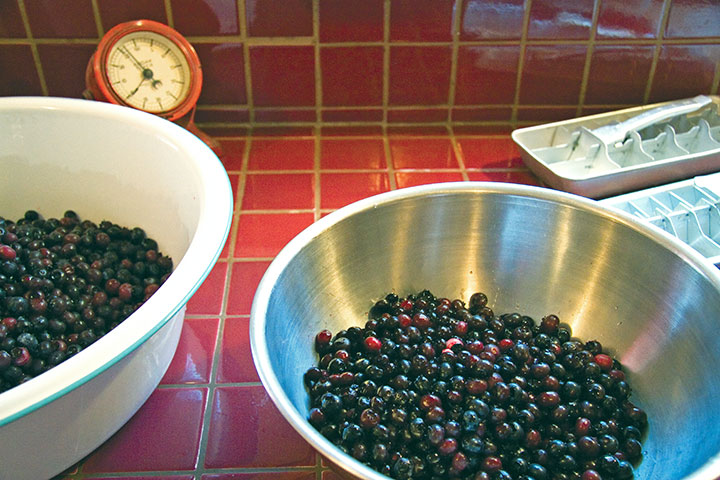
Here’s what the split berries look like; they should feel squishy, and you should be able to see the pale interior flesh on some of them. (Sorry about the photo quality—that red tile just kills the light.)
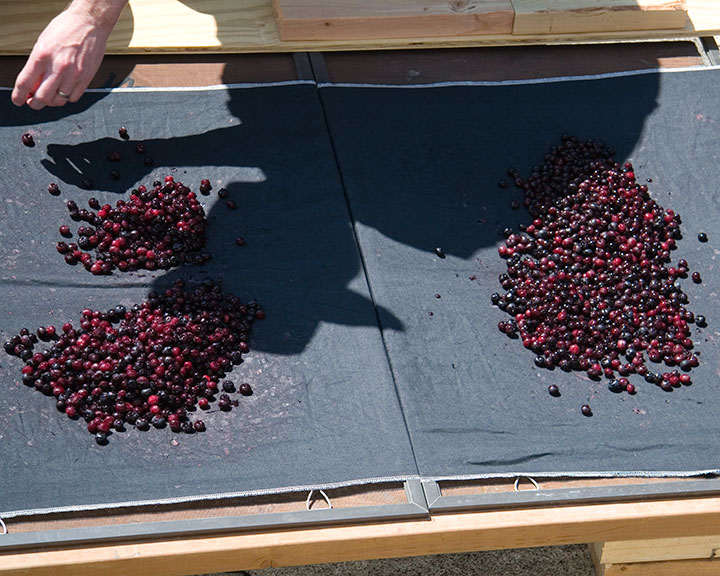
Okay, now you’re ready to take ’em outside. Distribute the berries evenly over the cloth-covered screens,

and spread them out until you have a single layer.

Now, just put the glass back into place, and let the sun do the work. It’s amazing how quickly the humidity inside the glass disappears, and how hot it gets in there. The ideal temperature for drying blueberries is about 140°F, but we’ve already seen our dryer get up to 155°. It doesn’t seem to hurt the final product, but at the hottest part of the day we cover the glass with a sheet for an hour or so, just to cool it down a bit.
About once a day it’s good to redistribute and un-stick the fruit, which helps it dry faster and more evenly. It takes about three full, sunny days to dry the berries completely—unlike raisins, you want blueberries to be so dry they rattle. You should end up with hard little husks that don’t squish and don’t stick together.
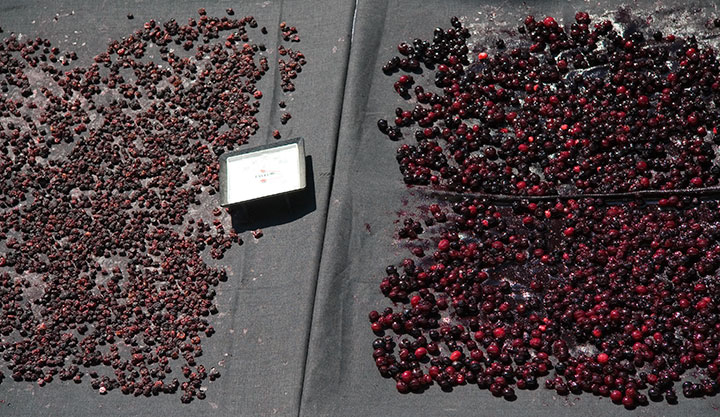
Here you can see the difference between fresh, split berries and ones that are almost done. Once they’re dry, pasteurize them for fifteen minutes in a 175° oven to kill any residual germs, and store in a sealed, air-tight jar.
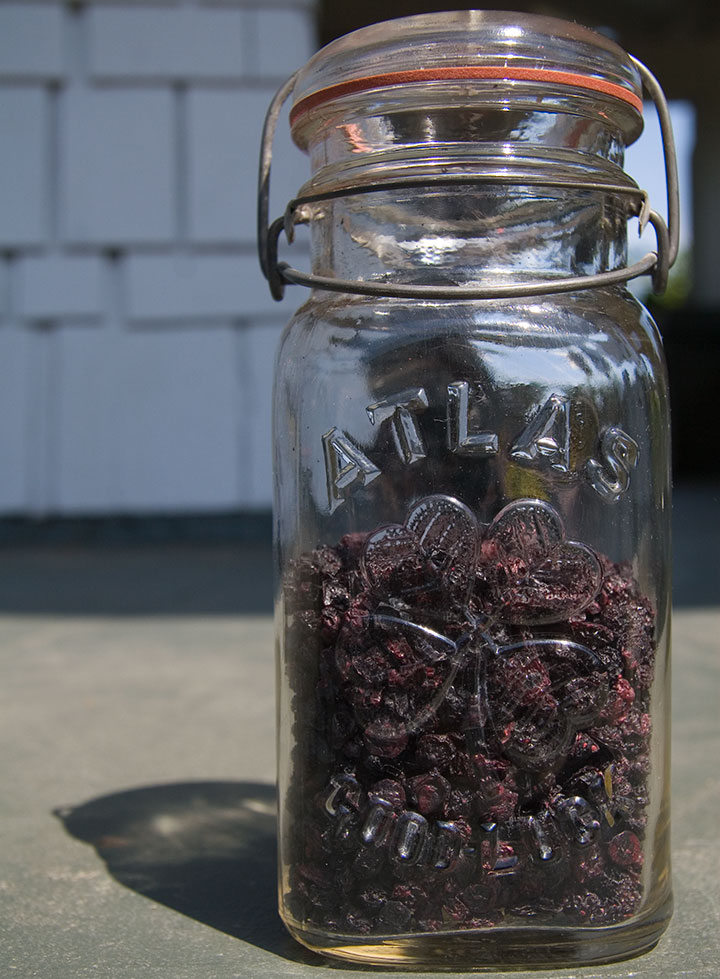
Since we’ll probably use our dried berries for a wide variety of recipes, we left them unsweetened. That way we can reconstitute them for pancakes, sauces and baked goods this winter without any recipe guesswork. They’re still sweet enough to eat plain, too (trail mix, anyone?), although if you prefer your berries pre-sweetened, you can coat them in simple syrup before drying.
Either way, you’ll end up with sunshine in a jar.
July 13th, 2009
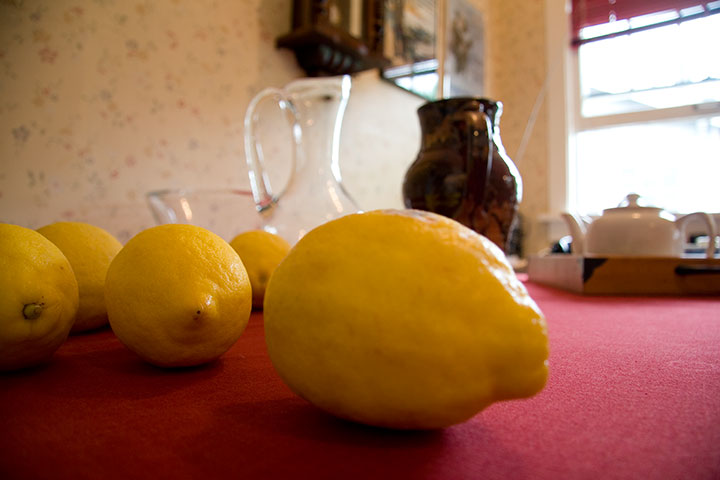
First, invite your family down for the day. Squeeze out some fresh lemonade;
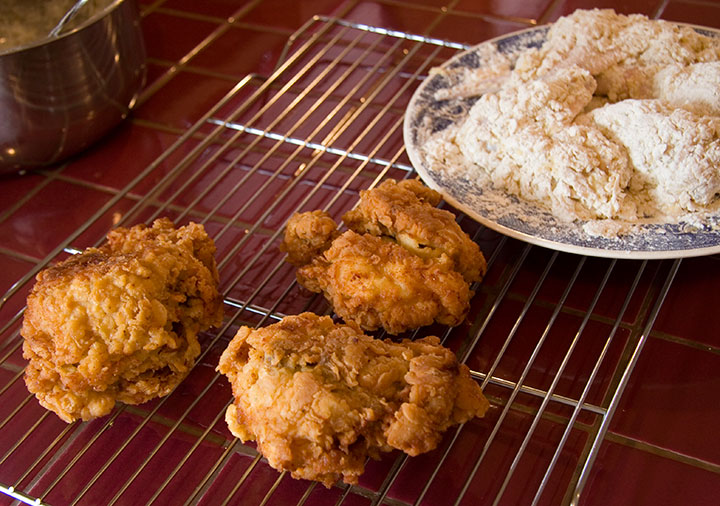
and fry up a free-range chicken.

Then mix up some cream, sugar, and fresh berries (plus just a pinch of that lemon juice to bring out the flavor);
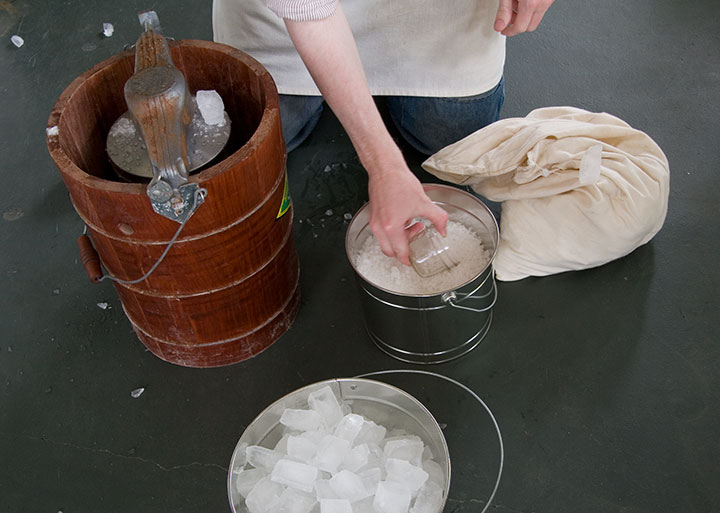
pack ice and salt around it;
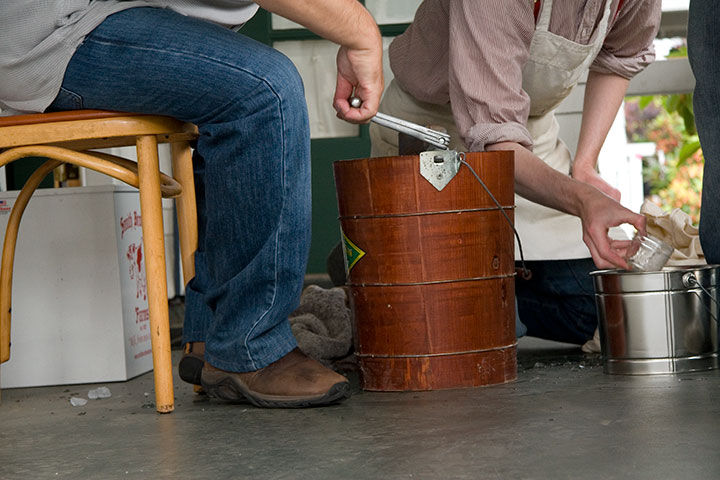
and start crankin’.
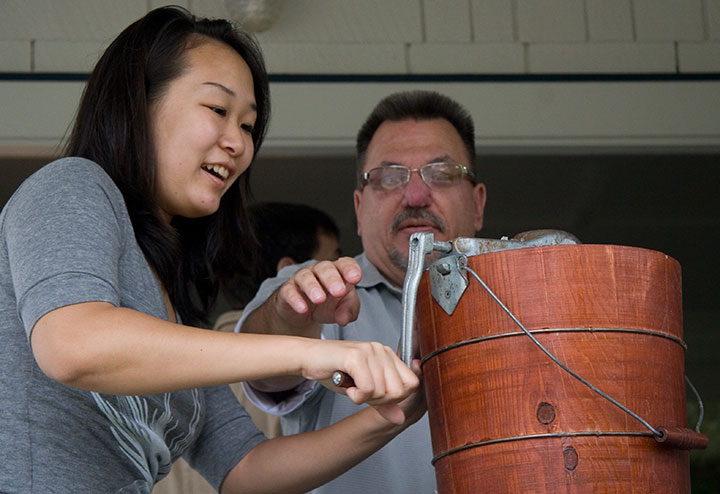
Let everyone pitch in—the longer you churn, the harder it’ll get.
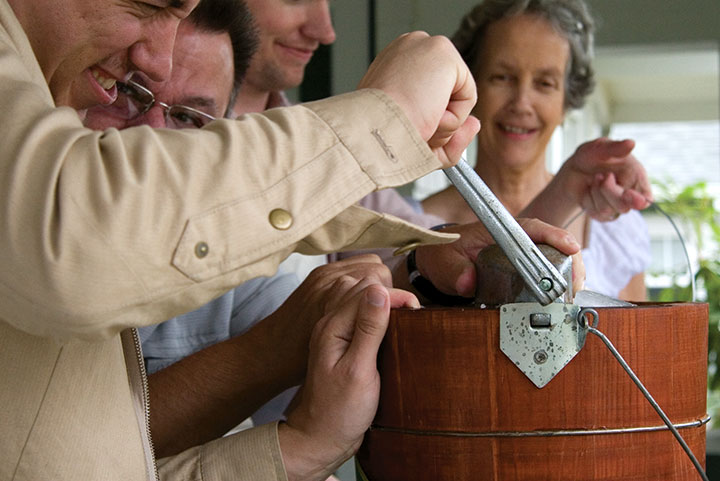
Finally, when even teamwork won’t turn that handle, you’re ready.
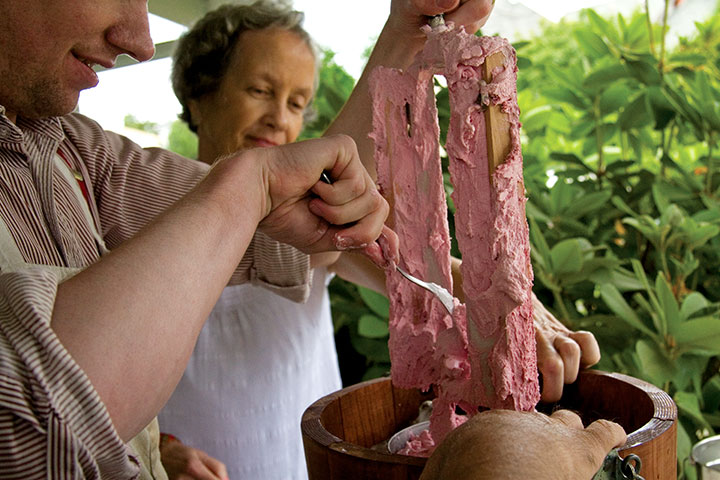
And hey, presto—
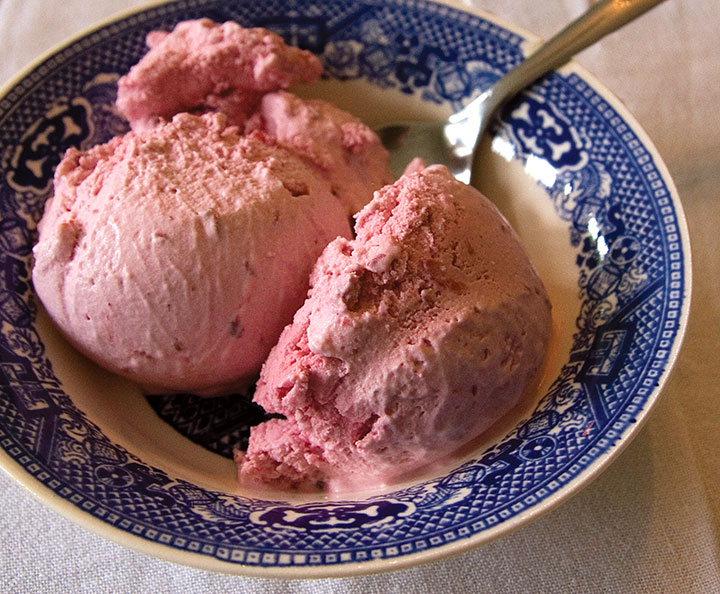
summer in a bowl.
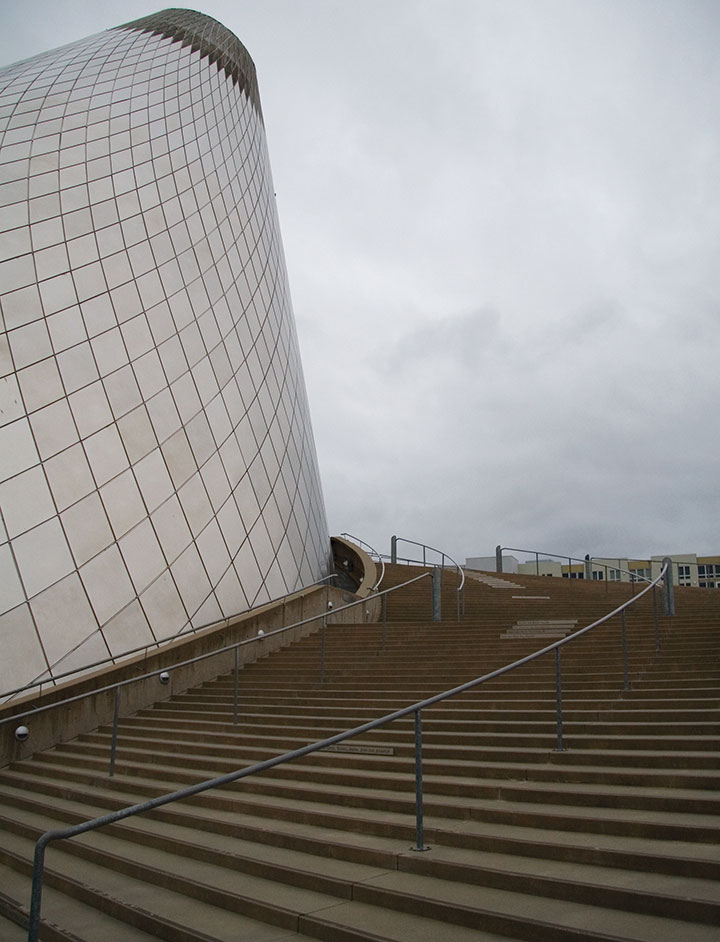
If all that ice cream gives you a chill, just head for the hot shop;

gather around the fire;
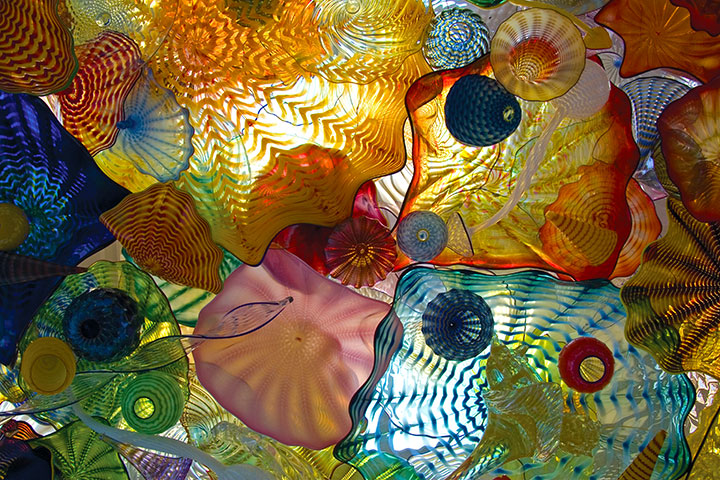
and bask in the perfect day you made.
June 19th, 2009
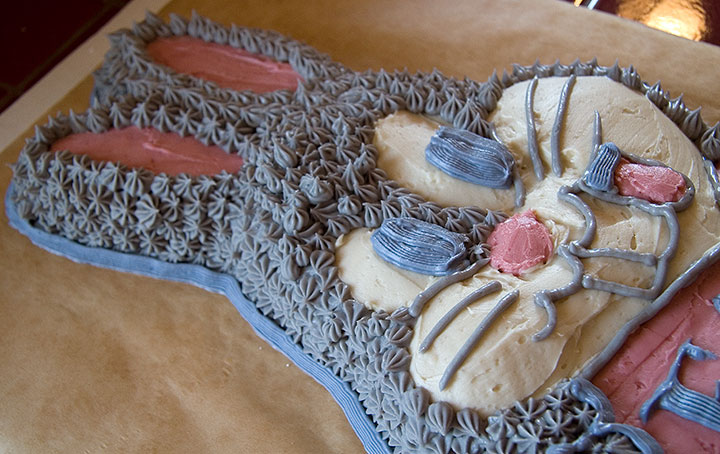
What with a string of out-of-town visitors and deadlines to distract us, the Tailor and I let our first anniversary slide by without much fanfare. This week, however, we remembered the nostalgic, circa-early-1980s, licensed-character Wilton cake pans we borrowed from his parents last winter, and decided a belated, totally un-wedding-like anniversary cake was in order. (Sane people just go out for a nice dinner.)
When I was a kid I loved the weird, hairy-looking frosting on those Cookie Monster and Pac Man cakes, but I don’t remember actually having one at any of my birthdays (I usually requested pumpkin pie, still my favorite). So this was my chance to both relive and rewrite my childhood—and to try my hand at creating that bizarre, strangely satisfying frosting texture.
The Tailor found a white cake recipe in our favorite cook book (we have three copies!), and we modified an icing recipe to include only butter, sugar, vanilla and cream (about the only thing you’ll ever see me using shortening for is cleaning letterpress equipment). Then I noticed that the cake mold left room to write a message in icing—and my eyes strayed to my decorating tip, which was shaped curiously like a calligraphy pen nib. So I couldn’t resist attempting a little edible typography. The cake wasn’t large enough to write “Happy Anniversary” with any typographic flair—and that’s not my style anyway. So I went with something a little more down-to-earth, and, well, appropriate to the medium:
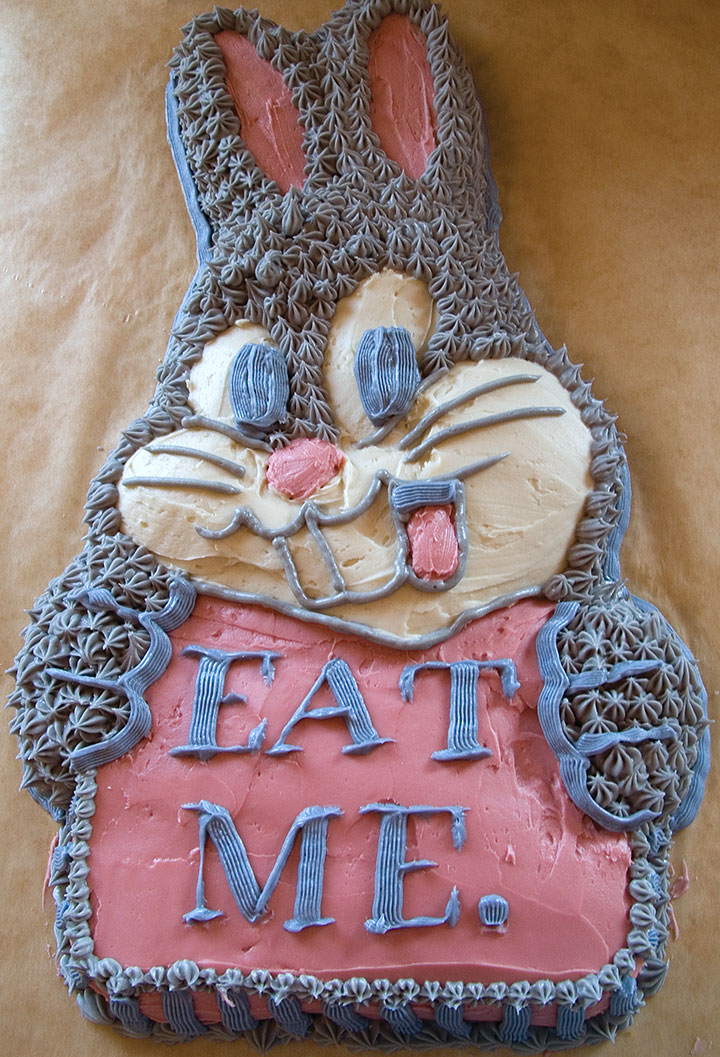
(We did. Most joyfully. My edible kerning needs some work, though…)




![Chandler O'Leary [logo]](https://chandleroleary.com/wp-content/themes/chandleroleary/images/logo.png)


















































